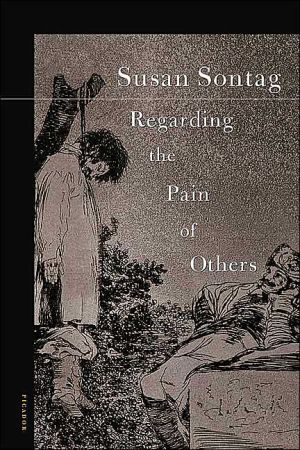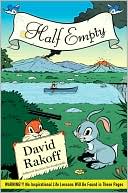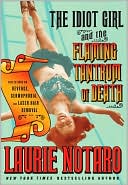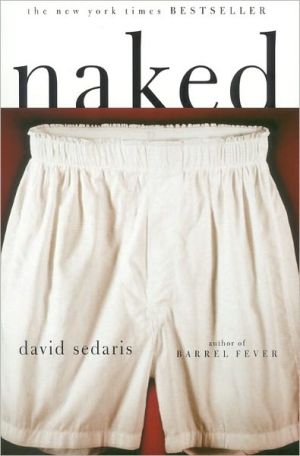Regarding the Pain of Others
Twenty-five years after her classic On Photography, Susan Sontag returns to the subject of visual representations of war and violence in our culture today.\ How does the spectacle of the sufferings of others (via television or newsprint) affect us? Are viewers inured—or incited—to violence by the depiction of cruelty? In Regarding the Pain of Others, Susan Sontag takes a fresh look at the representation of atrocity—from Goya's The Disasters of War to photographs of the American Civil War,...
Search in google:
A brilliant, clear-eyed new consideration of the visual representation of violence in our culture—its ubiquity, meanings, and effectsWatching the evening news offers constant evidence of atrocity—a daily commonplace in our "society of spectacle." But are viewers inured -or incited—to violence by the daily depiction of cruelty and horror? Is the viewer's perception of reality eroded by the universal availability of imagery intended to shock? In her first full-scale investigation of the role of imagery in our culture since her now-classic book On Photography defined the terms of the debate twenty-five years ago, Susan Sontag cuts through circular arguments about how pictures can inspire dissent or foster violence as she takes a fresh look at the representation of atrocity—from Goya's The Disasters of War to photographs of the American Civil War, lynchings of blacks in the South, and Dachau and Auschwitz to contemporary horrific images of Bosnia, Sierra Leone, Rwanda, and New York City on September 11, 2001.As John Berger wrote when On Photography was first published, "All future discussions or analysis of the role of photography in the affluent mass-media societies is now bound to begin with her book." Sontag's new book, a startling reappraisal of the intersection of "information", "news," "art," and politics in the contemporary depiction of war and disaster, will be equally essential. It will forever alter our thinking about the uses and meanings of images in our world.Los Angeles TimesSontag is in top form: firing devastating questions and providing no answers for shelter. She hands us no morality meter, designed to scan a picture and flash up "necessary experience" in green or "atrocity-porn" in red. Instead, she quotes Plato -- the tale of Leontius reluctantly feasting his eyes on executed criminals -- to show that "the attraction of mutilated bodies" has always been recognized, not least in the obsession of Christian art with naked bodies in pain. Only in the 17th century are depictions of atrocity hitched to the notion that war is cruel and should be prevented. But "most depictions of tormented, mutilated bodies do arouse a prurient interest.... All images that display the violation of an attractive body are, to a certain degree, pornographic." (Sontag exonerates Goya, whose brutalized victims are, like their torturers and violators, "heavy, and thickly clothed"). — Neal Ascherson
REGARDING THE PAIN OF OTHERS\ \ By Susan Sontag \ FARRAR, STRAUS AND GIROUX\ Copyright © 2003 Susan Sontag\ All right reserved.\ ISBN: 0374248583 \ \ \ \ Chapter One\ In June 1938 Virginia Woolf published Three Guineas, her brave, unwelcomed reflections on the roots of war. Written during the preceding two years, while she and most of her intimates and fellow writers were rapt by the advancing fascist insurrection in Spain, the book was couched as the very tardy reply to a letter from an eminent lawyer in London who had asked, "How in your opinion are we to prevent war?" Woolf begins by observing tartly that a truthful dialogue between them may not be possible. For though they belong to the same class, "the educated class," a vast gulf separates them: the lawyer is a man and she is a woman. Men make war. Men (most men) like war, since for men there is "some glory, some necessity, some satisfaction in fighting" that women (most women) do not feel or enjoy. What does an educated-read: privileged, well-off-woman like her know of war? Can her recoil from its allure be like his? \ Let us test this "difficulty of communication," Woolf proposes, by looking together at images of war. The images are some of the photographs the beleaguered Spanish government has been sending out twice a week; she footnotes: "Written in the winter of 1936-37." Let's see, Woolf writes, "whether when we look at the same photographs we feelthe same things." She continues:\ This morning's collection contains the photograph of what might be a man's body, or a woman's; it is so mutilated that it might, on the other hand, be the body of a pig. But those certainly are dead children, and that undoubtedly is the section of a house. A bomb has torn open the side; there is still a bird-cage hanging in what was presumably the sitting room ...\ The quickest, driest way to convey the inner commotion caused by these photographs is by noting that one can't always make out the subject, so thorough is the ruin of flesh and stone they depict. And from there Woolf speeds to her conclusion. We do have the same responses, "however different the education, the traditions behind us," she says to the lawyer. Her evidence: both "we"-here women are the "we"-and you might well respond in the same words.\ You, Sir, call them "horror and disgust." We also call them horror and disgust ... War, you say, is an abomination; a barbarity; war must be stopped at whatever cost. And we echo your words. War is an abomination; a barbarity; war must be stopped.\ Who believes today that war can be abolished? No one, not even pacifists. We hope only (so far in vain) to stop genocide and to bring to justice those who commit gross violations of the laws of war (for there are laws of war, to which combatants should be held), and to be able to stop specific wars by imposing negotiated alternatives to armed conflict. It may be hard to credit the desperate resolve produced by the aftershock of the First World War, when the realization of the ruin Europe had brought on itself took hold. Condemning war as such did not seem so futile or irrelevant in the wake of the paper fantasies of the Kellogg-Briand Pact of 1928, in which fifteen leading nations, including the United States, France, Great Britain, Germany, Italy, and Japan, solemnly renounced war as an instrument of national policy; even Freud and Einstein were drawn into the debate with a public exchange of letters in 1932 titled "Why War?" Woolf's Three Guineas, appearing toward the close of nearly two decades of plangent denunciations of war, offered the originality (which made this the least well received of all her books) of focusing on what was regarded as too obvious or inapposite to be mentioned, much less brooded over: that war is a man's game-that the killing machine has a gender, and it is male. Nevertheless, the temerity of Woolf's version of "Why War?" does not make her revulsion against war any less conventional in its rhetoric, in its summations, rich in repeated phrases. And photographs of the victims of war are themselves a species of rhetoric. They reiterate. They simplify. They agitate. They create the illusion of consensus.\ Invoking this hypothetical shared experience ("we are seeing with you the same dead bodies, the same ruined houses"), Woolf professes to believe that the shock of such pictures cannot fail to unite people of good will. Does it? To be sure, Woolf and the unnamed addressee of this book-length letter are not any two people. Although they are separated by the age-old affinities of feeling and practice of their respective sexes, as Woolf has reminded him, the lawyer is hardly a standard-issue bellicose male. His antiwar opinions are no more in doubt than are hers. After all, his question was not, What are your thoughts about preventing war? It was, How in your opinion are we to prevent war?\ It is this "we" that Woolf challenges at the start of her book: she refuses to allow her interlocutor to take a "we" for granted. But into this "we," after the pages devoted to the feminist point, she then subsides.\ No "we" should be taken for granted when the subject is looking at other people's pain.\ * * *\ Who are the "we" at whom such shock-pictures are aimed? That "we" would include not just the sympathizers of a smallish nation or a stateless people fighting for its life, but-a far larger constituency-those only nominally concerned about some nasty war taking place in another country. The photographs are a means of making "real" (or "more real") matters that the privileged and the merely safe might prefer to ignore.\ "Here then on the table before us are photographs," Woolf writes of the thought experiment she is proposing to the reader as well as to the spectral lawyer, who is eminent enough, as she mentions, to have K.C., King's Counsel, after his name-and may or may not be a real person. Imagine then a spread of loose photographs extracted from an envelope that arrived in the morning post. They show the mangled bodies of adults and children. They show how war evacuates, shatters, breaks apart, levels the built world. "A bomb has torn open the side," Woolf writes of the house in one of the pictures. To be sure, a cityscape is not made of flesh. Still, sheared-off buildings are almost as eloquent as bodies in the street. (Kabul, Sarajevo, East Mostar, Grozny, sixteen acres of lower Manhattan after September 11, 2001, the refugee camp in Jenin ...) Look, the photographs say, this is what it's like. This is what war does. And that, that is what it does, too. War tears, rends. War rips open, eviscerates. War scorches. War dismembers. War ruins.\ Not to be pained by these pictures, not to recoil from them, not to strive to abolish what causes this havoc, this carnage-these, for Woolf, would be the reactions of a moral monster. And, she is saying, we are not monsters, we members of the educated class. Our failure is one of imagination, of empathy: we have failed to hold this reality in mind.\ But is it true that these photographs, documenting the slaughter of noncombatants rather than the clash of armies, could only stimulate the repudiation of war? Surely they could also foster greater militancy on behalf of the Republic. Isn't this what they were meant to do? The agreement between Woolf and the lawyer seems entirely presumptive, with the grisly photographs confirming an opinion already held in common. Had the question been, How can we best contribute to the defense of the Spanish Republic against the forces of militarist and clerical fascism?, the photographs might instead have reinforced their belief in the justness of that struggle.\ The pictures Woolf has conjured up do not in fact show what war, war as such, does. They show a particular way of waging war, a way at that time routinely described as "barbaric," in which civilians are the target. General Franco was using the same tactics of bombardment, massacre, torture, and the killing and mutilation of prisoners that he had perfected as a commanding officer in Morocco in the 1920s. Then, more acceptably to ruling powers, his victims had been Spain's colonial subjects, darker-hued and infidels to boot; now his victims were compatriots. To read in the pictures, as Woolf does, only what confirms a general abhorrence of war is to stand back from an engagement with Spain as a country with a history. It is to dismiss politics.\ For Woolf, as for many antiwar polemicists, war is generic, and the images she describes are of anonymous, generic victims. The pictures sent out by the government in Madrid seem, improbably, not to have been labeled. (Or perhaps Woolf is simply assuming that a photograph should speak for itself.) But the case against war does not rely on information about who and when and where; the arbitrariness of the relentless slaughter is evidence enough. To those who are sure that right is on one side, oppression and injustice on the other, and that the fighting must go on, what matters is precisely who is killed and by whom. To an Israeli Jew, a photograph of a child torn apart in the attack on the Sbarro pizzeria in downtown Jerusalem is first of all a photograph of a Jewish child killed by a Palestinian suicide-bomber. To a Palestinian, a photograph of a child torn apart by a tank round in Gaza is first of all a photograph of a Palestinian child killed by Israeli ordnance. To the militant, identity is everything. And all photographs wait to be explained or falsified by their captions. During the fighting between Serbs and Croats at the beginning of the recent Balkan wars, the same photographs of children killed in the shelling of a village were passed around at both Serb and Croat propaganda briefings. Alter the caption, and the children's deaths could be used and reused.\ Images of dead civilians and smashed houses may serve to quicken hatred of the foe, as did the hourly reruns by Al Jazeera, the Arab satellite television network based in Qatar, of the destruction in the Jenin refugee camp in April 2002. Incendiary as that footage was to the many who watch Al Jazeera throughout the world, it did not tell them anything about the Israeli army they were not already primed to believe. In contrast, images offering evidence that contradicts cherished pieties are invariably dismissed as having been staged for the camera. To photographic corroboration of the atrocities committed by one's own side, the standard response is that the pictures are a fabrication, that no such atrocity ever took place, those were bodies the other side had brought in trucks from the city morgue and placed about the street, or that, yes, it happened and it was the other side who did it, to themselves. Thus the chief of propaganda for Franco's Nationalist rebellion maintained that it was the Basques who had destroyed their own ancient town and former capital, Guernica, on April 26, 1937, by placing dynamite in the sewers (in a later version, by dropping bombs manufactured in Basque territory) in order to inspire indignation abroad and reinforce the Republican resistance. And thus a majority of Serbs living in Serbia or abroad maintained right to the end of the Serb siege of Sarajevo, and even after, that the Bosnians themselves perpetrated the horrific "breadline massacre" in May 1992 and "market massacre" in February 1994, lobbing large-caliber shells into the center of their capital or planting mines in order to create some exceptionally gruesome sights for the foreign journalists' cameras and rally more international support for the Bosnian side.\ Photographs of mutilated bodies certainly can be used the way Woolf does, to vivify the condemnation of war, and may bring home, for a spell, a portion of its reality to those who have no experience of war at all. However, someone who accepts that in the world as currently divided war can become inevitable, and even just, might reply that the photographs supply no evidence, none at all, for renouncing war-except to those for whom the notions of valor and sacrifice have been emptied of meaning and credibility. The destructiveness of war-short of total destruction, which is not war but suicide-is not in itself an argument against waging war unless one thinks (as few people actually do think) that violence is always unjustifiable, that force is always and in all circumstances wrong-wrong because, as Simone Weil affirms in her sublime essay on war, "The Iliad, or The Poem of Force" (1940), violence turns anybody subjected to it into a thing. No, retort those who in a given situation see no alternative to armed struggle, violence can exalt someone subjected to it into a martyr or a hero.\ In fact, there are many uses of the innumerable opportunities a modern life supplies for regarding-at a distance, through the medium of photography-other people's pain. Photographs of an atrocity may give rise to opposing responses. A call for peace. A cry for revenge. Or simply the bemused awareness, continually restocked by photographic information, that terrible things happen. Who can forget the three color pictures by Tyler Hicks that The New York Times ran across the upper half of the first page of its daily section devoted to America's new war, "A Nation Challenged," on November 13, 2001? The triptych depicted the fate of a wounded Taliban soldier in uniform who had been found in a ditch by Northern Alliance soldiers advancing toward Kabul. First panel: being dragged on his back by two of his captors-one has grabbed an arm, the other a leg-along a rocky road. Second panel (the camera is very near): surrounded, gazing up in terror as he is being pulled to his feet. Third panel: at the moment of death, supine with arms outstretched and knees bent, naked and bloodied from the waist down, being finished off by the military mob that has gathered to butcher him. An ample reservoir of stoicism is needed to get through the great newspaper of record each morning, given the likelihood of seeing photographs that could make you cry. And the pity and disgust that pictures like Hicks's inspire should not distract you from asking what pictures, whose cruelties, whose deaths are not being shown.\ * * *\ For a long time some people believed that if the horror could be made vivid enough, most people would finally take in the outrageousness, the insanity of war.\ Fourteen years before Woolf published Three Guineas-in 1924, on the tenth anniversary of the national mobilization in Germany for the First World War-the conscientious objector Ernst Friedrich published his Krieg dem Kriege! (War Against War!). This is photography as shock therapy: an album of more than one hundred and eighty photographs mostly drawn from German military and medical archives, many of which were deemed unpublishable by government censors while the war was on.\ \ Continues...\ \ \ \ Excerpted from REGARDING THE PAIN OF OTHERS by Susan Sontag Copyright © 2003 by Susan Sontag\ Excerpted by permission. All rights reserved. No part of this excerpt may be reproduced or reprinted without permission in writing from the publisher. \ \
\ From the Publisher"Wise and somber. . .Sontag's closing words acknowledge that there are realities which no picture can convey." —Los Angeles Times Book Review\ "The history of sensibility in a culture shaped by the mechanical reproduction of imagery....has always been one of the guiding preoccupations of her best work, from Against Interpretation to The Volcano Lover....Regarding the Pain of Others invites, and rewards, more than one reading." —Newsday\ "For 30 years, Susan Sontag has been challenging an entire generation to think about the things that frighten us most: war, disease, death. Her books illuminate without simplifying, complicate without obfuscating, and insist above all that to ignore what threatens us is both irresponsible and dangerous." —O, The Oprah Magazine\ "A timely meditation on politics and ethics. . .extraordinary . . .Sontag's insight and erudition are profound." —The Atlanta Journal-Constitution\ "Regarding the Pain of Others bristles with a sense of commitment—to seeing the world as it is, to worrying about the ways it is represented, even to making some gesture in the direction of changing it. . .the performance is thrilling to witness." —The New York Times Magazine\ "A fiercely challenging book. . .immensely thought-provoking." —The Christian Science Monitor\ \ \ \ \ \ The Washington PostSontag's book does not anticipate the current role of photographers in Iraq. (Part of the book's argument was delivered as an Amnesty Lecture at Oxford University in February 2001 and took much of its inspiration from Sontag's reconsideration of Holocaust photography.) But the Iraq war transforms Regarding the Pain of Others into more than a smart-set sideshow about an intellectual's reversal. As the images come out of Iraq, Sontag's plainspoken, self-questioning book furnishes meditation of a high order. At times, she seems almost afraid to reach conclusions. But her oscillating and humbled mindfulness restores photography to its place in the humanist tradition. — Lorraine Adams\ \ \ Los Angeles TimesSontag is in top form: firing devastating questions and providing no answers for shelter. She hands us no morality meter, designed to scan a picture and flash up "necessary experience" in green or "atrocity-porn" in red. Instead, she quotes Plato -- the tale of Leontius reluctantly feasting his eyes on executed criminals -- to show that "the attraction of mutilated bodies" has always been recognized, not least in the obsession of Christian art with naked bodies in pain. Only in the 17th century are depictions of atrocity hitched to the notion that war is cruel and should be prevented. But "most depictions of tormented, mutilated bodies do arouse a prurient interest.... All images that display the violation of an attractive body are, to a certain degree, pornographic." (Sontag exonerates Goya, whose brutalized victims are, like their torturers and violators, "heavy, and thickly clothed"). — Neal Ascherson\ \ \ \ \ The New York TimesAs usual, she provokes. It probably isn't true that ''not even pacifists'' any longer believe war can be abolished, that photos have a ''deeper bite'' in the memory bank than movies or television, that ''the appetite for pictures showing bodies in pain is as keen, almost, as the desire for ones that show bodies naked,'' and that ''most depictions of tormented, mutilated bodies do arouse a prurient interest.'' I don't know, and neither does she. On the other hand, when she revises her own conclusions from On Photography to say she's no longer so sure that shock has ''term limits,'' or that ''repeated exposure'' in ''our culture of spectatorship neutralizes the moral force of photographs of atrocities,'' I agree with her for no other reason than I want to. Her job is not to win a verdict from a jury, but to make us think. — John Leonard\ \ \ \ \ Susan TekulveThis gripping debut novel examines how easily shrewd lies can be mistaken for acts of love. Spanning twenty-five years, it recounts the stories of three women who marry the same elusive man in succession. Alternately wise, charming and cold blooded, Ken Kimble is as charismatic as Mephistopheles, a sweet liar who promises each woman what she wants most of all in exchange for her complete devotion. To his first wife, Birdie Bell, he offers a way out of her small Southern town. To his second wife, Joan Cohen, a lonely heiress and breast cancer survivor, he offers hope for a final chance at love. His third wife, Dinah Whitacre, is a woman half his age who is disfigured by a birthmark on her face. Before marrying her, Kimble provides an operation that restores her beauty. With each successive marriage, Kimble gains wealth and worldly experience while his wives compromise themselves and fall apart. Haigh renders Kimble's sociopathic behavior in quiet, understated prose, carefully examining the mitigating circumstances that draw each woman to him. Though Kimble's rise to power drives the plot, the sophisticated portraits of his three wives provide the substance and intrigue in this book.\ \ \ \ \ Publishers WeeklyTwenty-six years after the publication of her influential collection of essays On Photography (1977), Sontag (In America) reconsiders ideas that are "now fast approaching the status of platitudes," especially the view that our capacity to respond to images of war and atrocity is being dulled by "the relentless diffusion of vulgar and appalling images" in our rapaciously media-driven culture. Sontag opens by describing Virginia Woolf's essay on the roots of war, "Three Guineas," in which Woolf described a set of gruesome photographs of mutilated bodies and buildings destroyed during the Spanish Civil War. Woolf wondered if there truly can be a "we" between man and woman in matters of war. Sontag sets out to reopen and enlarge the question. "No `we' should be taken for granted when the subject is looking at other people's pain," she writes. The "we" that Sontag has come to be much more aware of in the decades since On Photography is the world of the rich. She has come to doubt her youthful contention that repeated exposure to images of suffering necessarily shrivels sympathy, and she doubts even more the radical yet influential spin that others put on this critique-that reality itself has become a spectacle. "To speak of reality becoming a spectacle... universalizes the viewing habits of a small, educated population living in the rich part of the world...." Sontag reminds us that sincerity can turn a mere spectator into a witness, and that it is the heart rather than fancy rhetoric that can lead the mind to understanding. (Mar.) FYI: In a letter published in the January 13, 2003, issue of the New Yorker, Woolf scholar Jane Marcus asserts that Woolf never published the horrible war photos that she described-they appeared only in later editions of her antiwar essay. Instead, Woolf substituted images of a general, an archbishop, a judge-wordlessly insisting that her readers constantly consider the men of power who make wars. Marcus assumes that Sontag was drawing her conclusions from a later edition without realizing that she was crying Woolf. Copyright 2003 Reed Business Information.\ \ \ \ \ Library JournalImages of violence and suffering, whether photographic representations or artistic interpretations, are the subject of Sontag's (On Photography) latest dissection of modern culture. In meticulously documented and compulsively readable prose, this National Book Award-winning author explores a formidable array of associated topics. The complex relationships of image maker, object, image, and image viewer; the history of war photography; the image as propaganda; censorship, the staged photograph, and authenticity vs. aestheticism; the question of overexposure to images of atrocities; and the events of September 11, 2001, are only a brief sample of subjects she analyzes in these provocative and articulate essays. In one telling essay, she elaborates on the concept of the "memory museum" as a repository for photographic archives of suffering and atrocity and wonders why, given the success of the Holocaust Museum, there is as yet no museum devoted to the history of slavery in America. Perhaps, she speculates, some memories are simply too dangerous to social stability to be commemorated. Academic libraries supporting programs in journalism (especially photojournalism), communications, psychology, sociology, military history, and art history will find this work invaluable, and it could also be useful in high schools to spark discussion in current events and history classes. All libraries, regardless of type, size, or demographics, should own this book. [Previewed in Prepub Alert, LJ 11/15/02.]-M.C. Duhig, Lib. Ctr. of Point Park Coll. & Carnegie Lib. of Pittsburgh Copyright 2003 Reed Business Information.\ \ \ \ \ Kirkus ReviewsWith a glance back at the essays in On Photography (1977), the eminent intellectual, critic, and writer cobbles together a defense of war photography--with a result that’s as much maunder as miracle. The slightly superior, ever-unflappable tone will be familiar here to Sontag readers, as will be the wonderful aperçus that come along in a kind of pearls-on-a-string parade--"All memory is individual, unreproducible--it dies with each person," for example, or "To remember is, more and more, not to recall a story but to be able to call up a picture," or "Narratives can make us understand. Photographs do something else: they haunt us." Familiar, too, is the Sontagian pleasure of watching a mind roam through fields of history and reading--as the thinker touches down one moment in Plato, at another in Leonardo or Edmund Burke, all the while keeping up knowledgeably detailed references to politics and conflict from the Crimean war up to Somalia and Bosnia. And yet, for all its author’s capabilities, the essay remains only imperfectly satisfying. From Matthew Brady to now, photos of death and war have raised the question of whether prurience or sympathy is raised in the viewer of such images, degradation and moral numbing on the one hand or any kind of useful understanding on the other. Sontag reviews and explores this old question, and her answer, though without doubt the right one--"Let the atrocious images haunt us"--leads her to unexpected banalities ("There is simply too much injustice in the world") and an unfocused ending that all but randomly touches on great matters--whether the mass media create passivity, for example--and just as inexplicably glances away from them ("But it’s probablynot true that people are responding less"), leaving the greatest question--whether there is any "way to guarantee contemplative . . . space for anything now"--nudged at only lightly, and left to slumber on. Moments of brilliance and wonder amid the generally disappointing.\ \








